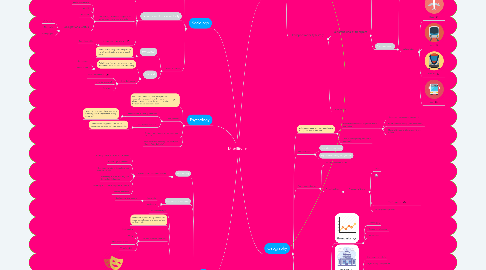
1. Sociology
1.1. Definition: shifting from one social status to another
1.2. Societies organized by social class. The mobility of:
1.2.1. Indiviudals
1.2.2. families
1.2.3. households
1.3. Great or weak social mobility
1.3.1. Gender and race can limit upward social mobility
1.3.2. one's ability to achieve a higher social status can depend on many factors
1.3.2.1. Social connections
1.3.2.2. Wealth
1.3.2.3. Education
1.3.2.4. Occupational status
1.3.2.4.1. White collar
1.3.2.4.2. Blue collar
1.3.2.4.3. Unemployed
1.3.3. Gender mobility
1.3.3.1. Female mobility
1.4. 2 kind of mobility
1.4.1. Horizontal
1.4.1.1. Definition: switching from one position to another without a change in social status
1.4.2. Vertical
1.4.2.1. Definition: refers to a person's or group's movement up or down a status hierarchy
1.4.2.1.1. Higher status
1.4.2.1.2. Lower status
1.4.2.2. 3 kind of types:
1.4.2.2.1. Inter-Generational
1.4.2.2.2. Intra-Generational
1.4.2.2.3. Structural
2. Psychology
2.1. Definition: the individual's perceptions of career structures and his or her beliefs about how much he or she was constrained by them or can transcend them
2.2. 2 components
2.2.1. Organizational mobility preference
2.2.1.1. Definition: "the strenght of interest in remaining with a single (or multiple) employer's"
2.2.2. Boundaryless mindset
2.2.2.1. Definition: one's general attitude to working across organizational boundaries
2.3. Culture has influence on psychological mobility
2.4. Was measured by using "Boundaryless Career Attitude Scale"
3. Art
3.1. Artist mobility
3.1.1. Essential for a variety of reasons
3.1.1.1. Improving the artist carrer opportunities
3.1.1.2. Accessing new markets
3.1.1.3. Creating new jobs in the culture and creative sectors
3.1.1.4. Promoting cultural diversity and intercultural dialogue
3.1.1.5. Increasing and broadening their audience
3.1.1.6. Creating networks
3.2. Masterpiece in movement
3.2.1. Transports
3.2.1.1. Exchange with museum
3.2.2. Mechanics
3.3. Cultural mobility
3.3.1. Cultural exchange
3.3.2. Definition: the temporary cross-border movement of artists and other cultural professionals
3.3.3. Several forms of "mobility"
3.3.3.1. Residencies
3.3.3.2. Touring
3.3.3.3. Networking experiences
3.3.3.4. Virtual mobility
3.3.4. Disciplines
3.3.4.1. Performing arts
3.3.4.1.1. Theatre
3.3.4.1.2. Dance
3.3.4.1.3. Opera
3.3.4.1.4. Circus
3.3.4.2. Visual arts
3.3.4.3. Music
3.3.4.4. Literature
3.3.4.5. Cultural heritage
3.3.4.6. Cinema
4. History
4.1. Population mobility
4.1.1. Waves of migration
4.1.1.1. Pre-modern history
4.1.1.1.1. Roman conquests
4.1.1.1.2. Norman conquests
4.1.1.1.3. Colonization
4.1.1.2. Modern History
4.1.1.2.1. Migration to the US
4.1.1.2.2. World wars and aftermaths
4.1.1.3. Contemporary history
4.1.1.3.1. Climate Change migration
4.1.1.3.2. European migrant crisis
4.1.2. Different ethnies
4.2. Transport mobility history
4.2.1. different kind of transport
4.2.1.1. Private transport
4.2.1.1.1. Car
4.2.1.2. Common transport
4.2.1.2.1. Sustainable transport
4.2.1.2.2. Different kind
4.2.2. Hypermobility
5. Geography
5.1. Definition: measure of how populations and goods move over time
5.1.1. Statistic that measures migration within a population
5.1.1.1. The Current Population Survey (US)
5.1.1.2. Eurobarometer survey (European Union)
5.1.1.3. National Bureau of Statistics of China (China)
5.1.2. Used in demography and human geography
5.2. Different scale
5.2.1. International migrations
5.2.2. Regional commuting arrangements
5.3. Varies depending on
5.3.1. Established social norms
5.3.2. Formal policies
5.3.2.1. Freedom of travel
5.3.2.1.1. Laws
5.3.2.1.2. Visa/passports
5.3.2.1.3. Anti-migration policies
5.4. Has implications on
5.4.1. Economics
5.4.1.1. Labor supply
5.4.1.2. Ressources allocation
5.4.1.3. Remittances
5.4.2. Politics
5.4.2.1. Pro-migration policies
5.4.2.2. Against migration policies
5.4.3. Culture
5.4.3.1. Language
5.4.3.2. Culture exchange
5.4.3.3. Social Networks
5.4.4. Children, family and education
5.5. Influencing factors
5.5.1. Economic Reasons
5.5.1.1. War
5.5.1.2. Hanger
5.5.1.3. Income
5.5.2. Personal preferences
5.5.2.1. Climate
5.5.2.2. Individualization
5.5.2.3. Lifestyle
5.5.3. Social forces

